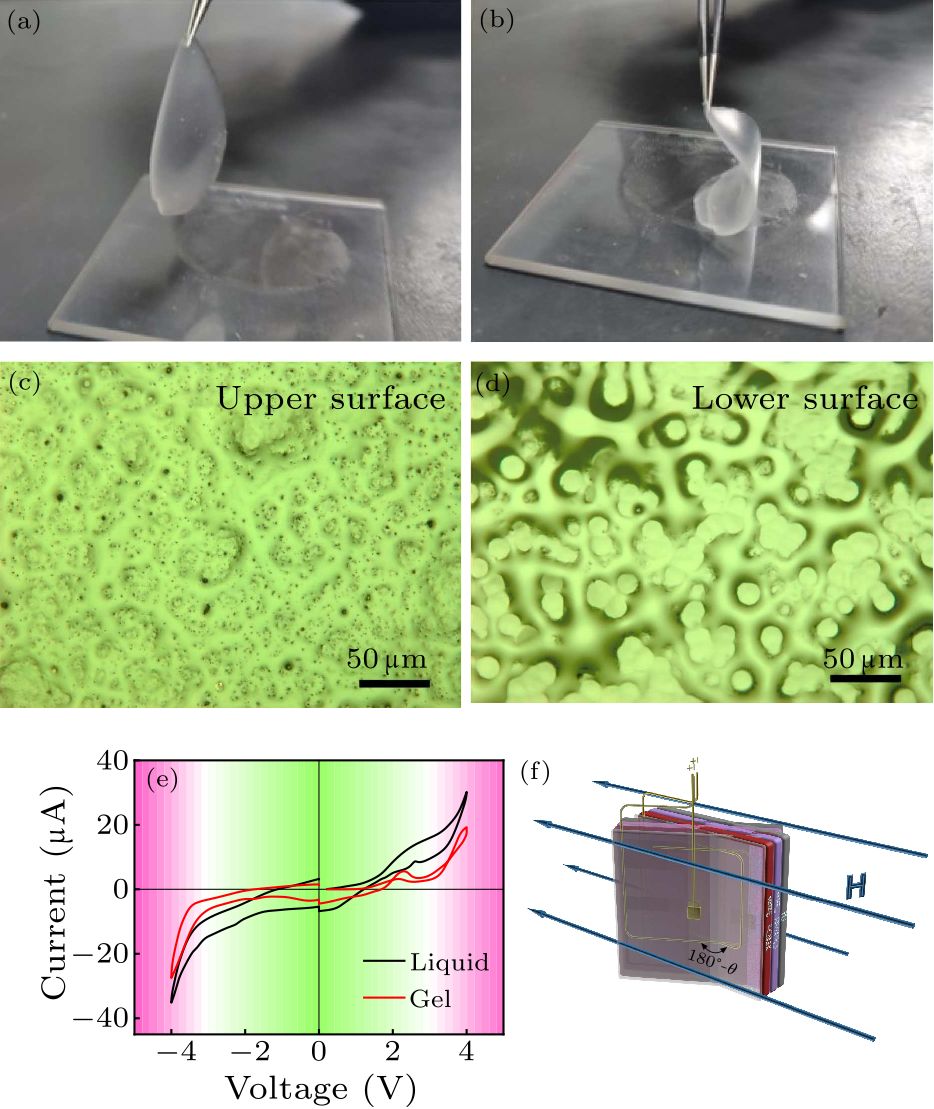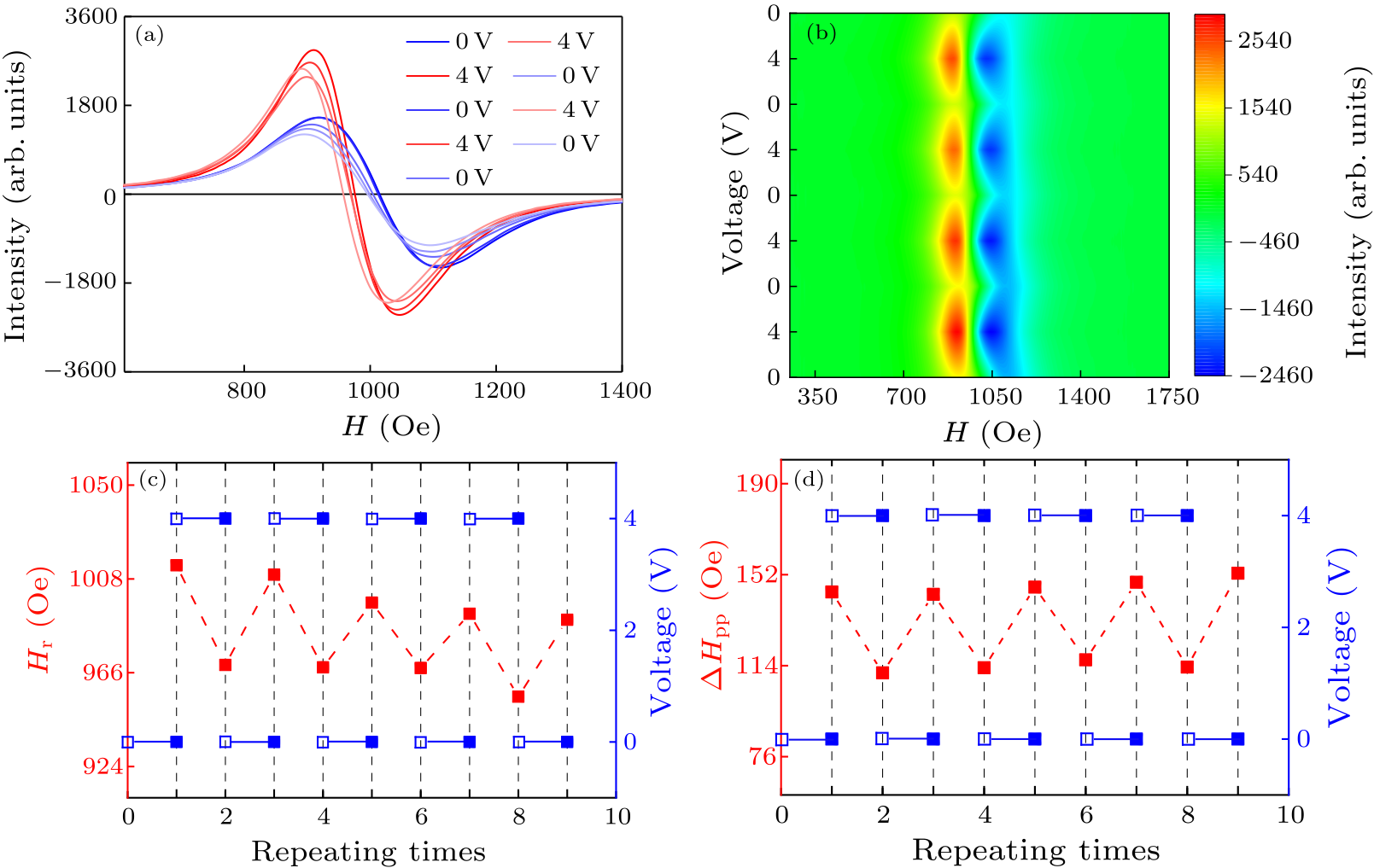
Fig. 1. Photograph of ionic gel when (a) upright and (b) bent. Photographs of the (c) upper and (d) lower surfaces of the ionic gel taken by an optical microscope. (e) The current-voltage ($I$–$V$) curves for ionic gel and ionic liquid. (f) Schematic diagram of in situ ferromagnetic resonance testing.

Fig. 2. (a) The initial FMR spectra when the angle between the magnetic field direction and the film plane gradually increases. (b) FMR spectra at different angles when the gate voltage is 4 V. The FMR spectra before and after the gate voltage are applied when the angle between the magnetic field direction and the film surface is (c) 0$^{\circ}$ and (d) 70$^{\circ}$.

Fig. 3. (a) Angular dependence of the resonance field ($H_{\rm r}$) for the initial state (0 V), the gated state (4 V), and the state back to 0 V from 4 V (+0 V). The purple curve shows the dependence of the $H_{\rm r,shift}$ on an angle. (b) Angular dependence of the peak-to-peak linewidth ($\Delta H_{\rm pp}$) for the initial state (0 V), the gated state (4 V), and the state back to 0 V from 4 V (+0 V). The orange curve shows the dependence of the $\Delta H_{\rm pp,shift}$ on an angle.

Fig. 4. (a) The FMR spectra tested when the gate voltage is repeatedly applied. (b) The mapping diagram of the FMR spectra when the gate voltage is repeatedly applied. Regulation diagram of (c) $H_{\rm r}$ and (d) $\Delta H_{\rm pp}$ by applying gate voltage repeatedly.
| [1] | Miron I M et al. 2011 Nature 476 189 | Perpendicular switching of a single ferromagnetic layer induced by in-plane current injection
| [2] | Zhu L et al. 2020 Adv. Electron. Mater. 6 1901131 | Energy‐Efficient Ultrafast SOT‐MRAMs Based on Low‐Resistivity Spin Hall Metal Au 0.25 Pt 0.75
| [3] | Fukami S, Anekawa T, Zhang C and Ohno H 2016 Nat. Nanotechnol. 11 621 | A spin–orbit torque switching scheme with collinear magnetic easy axis and current configuration
| [4] | Chen J Y et al. 2017 Appl. Phys. Lett. 111 012402 | Field-free spin-orbit torque switching of composite perpendicular CoFeB/Gd/CoFeB layers utilized for three-terminal magnetic tunnel junctions
| [5] | Chen X et al. 2018 Nat. Commun. 9 1 | Structural absorption by barbule microstructures of super black bird of paradise feathers
| [6] | Peng W L et al. 2019 Appl. Phys. Lett. 115 092402 | Enhancement of spin–orbit torque via interfacial hydrogen and oxygen ion manipulation
| [7] | Jia C et al. 2015 Sci. Rep. 5 11111 | Electric tuning of magnetization dynamics and electric field-induced negative magnetic permeability in nanoscale composite multiferroics
| [8] | Saha S et al. 2020 Phys. Rev. B 101 224401 | Control of damping in perpendicularly magnetized thin films using spin-orbit torques
| [9] | Woltersdorf G et al. 2009 Phys. Rev. Lett. 102 257602 | Damping by Slow Relaxing Rare Earth Impurities in
| [10] | Ganguly A et al. 2015 Sci. Rep. 5 17596 | Tunable Magnetization Dynamics in Interfacially Modified Ni81Fe19/Pt Bilayer Thin Film Microstructures
| [11] | Mondal S et al. 2017 Phys. Rev. B 96 054414 | All-optical detection of the spin Hall angle in heterostructures with varying thickness of the tungsten layer
| [12] | Hou W et al. 2019 ACS Appl. Mater. & Interfaces 11 21727 | Low-Voltage-Manipulating Spin Dynamics of Flexible Fe 3 O 4 Films through Ionic Gel Gating for Wearable Devices
| [13] | Li C et al. 2020 Curr. Appl. Phys. 20 883 | Ionic liquid gating control of magnetic anisotropy in Ni0.81Fe0.19 thin films
| [14] | Liu Y T et al. 2016 J. Appl. Phys. 120 023901 | Ionic-liquid gating of perpendicularly magnetised CoFeB/MgO thin films
| [15] | Hirai T et al. 2016 Appl. Phys. Express 9 063007 | Control of magnetic anisotropy in Pt/Co system using ionic liquid gating
| [16] | Qiu X et al. 2018 Adv. Mater. 30 1705699 | Characterization and Manipulation of Spin Orbit Torque in Magnetic Heterostructures
| [17] | Filianina M et al. 2020 Phys. Rev. Lett. 124 217701 | Electric-Field Control of Spin-Orbit Torques in Perpendicularly Magnetized Films
| [18] | Ryu J, Lee S, Lee K J and Park B G 2020 Adv. Mater. 32 1907148 | Current‐Induced Spin–Orbit Torques for Spintronic Applications
| [19] | Yi H T et al. 2014 Sci. Rep. 4 6604 | Tuning the metal-insulator crossover and magnetism in SrRuO3 by ionic gating
| [20] | Yamada S, Sato T and Toshiyoshi H 2017 Appl. Phys. Lett. 110 253501 | A pressure sensitive ionic gel FET for tactile sensing
| [21] | Zhao S et al. 2018 ACS Nano 12 7167 | Low-Voltage Control of (Co/Pt) x Perpendicular Magnetic Anisotropy Heterostructure for Flexible Spintronics
| [22] | Song C et al. 2016 Chin. Phys. B 25 067502 | Electrical control of magnetism in oxides
| [23] | Wang C et al. 2018 ACS Appl. Mater. & Interfaces 10 29750 | Voltage Control of Magnetic Anisotropy through Ionic Gel Gating for Flexible Spintronics
| [24] | Zhou C et al. 2018 Phys. Rev. Appl. 9 014006 | Strong Nonvolatile Magnon-Driven Magnetoelectric Coupling in Single-Crystal Heterostructures
| [25] | Cheng Y et al. 2018 Appl. Phys. Lett. 113 262403 | Thickness and angular dependent ferromagnetic resonance of ultra-low damping Co 25 Fe 75 epitaxial films
| [26] | Peria W K et al. 2020 Phys. Rev. B 101 134430 | Interplay of large two-magnon ferromagnetic resonance linewidths and low Gilbert damping in Heusler thin films
| [27] | Sun L et al. 2018 J. Magn. Magn. Mater. 451 480 | Anomalously large ferromagnetic resonance linewidth in the Gd/Cr/Fe film plane